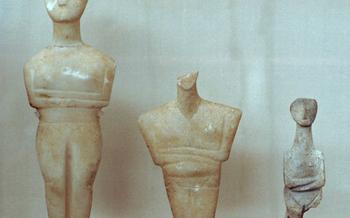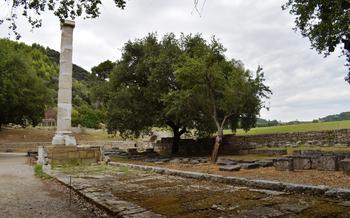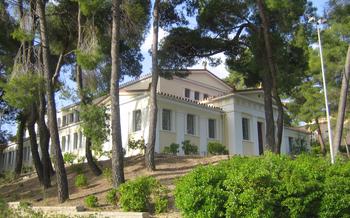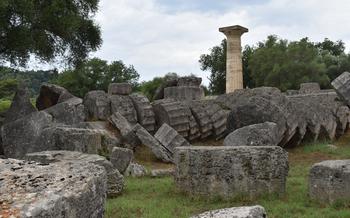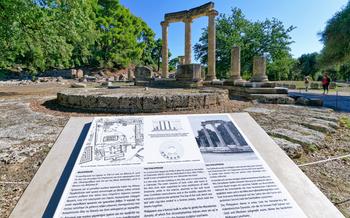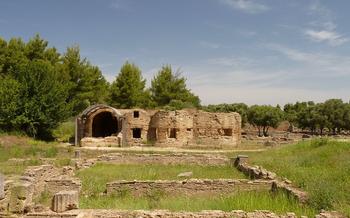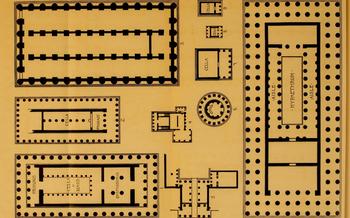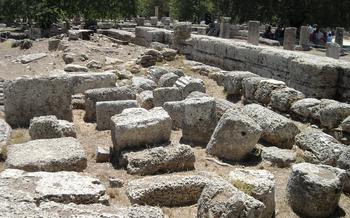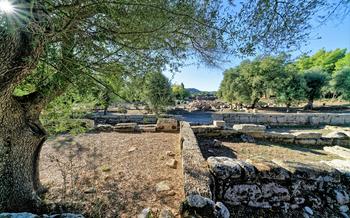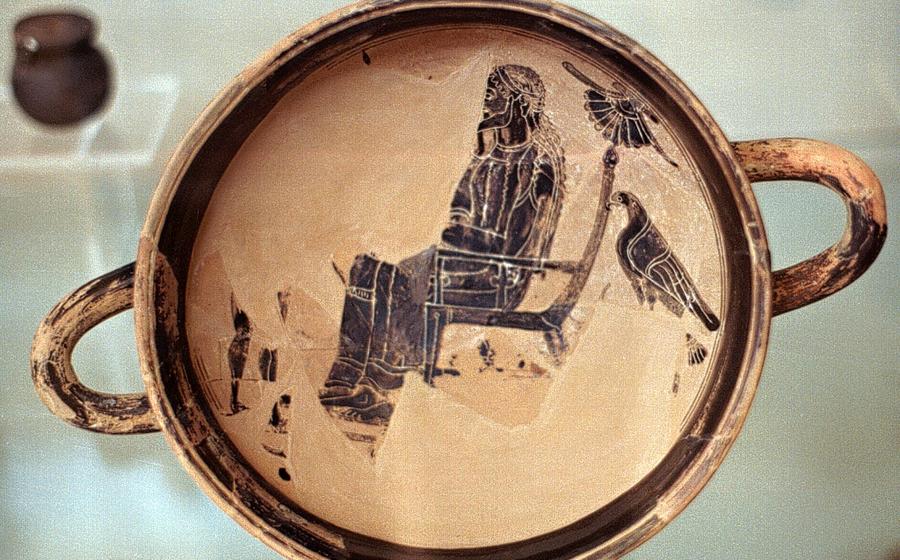
Archaeological Museum of Olympia
- A Journey Through Ancient Glory: Unveiling the Archaeological Museum of Olympia
- A Masterpiece of Ancient Architecture: The Temple of Zeus
- Witnessing Athletic Grandeur: The Ancient Olympic Stadium
- Honoring Victorious Athletes: The Museum's Statuary Collection
- Divine Encounters: The Sanctuary of Zeus
- Echoes of Chariot Races: The Hippodrome
- Triumph and Dedication: The Leonidaion
- Exploring the Museum's Collections: Beyond the Highlights
- Interactive Experiences: Bringing History to Life
- Capturing the Essence of Olympia: Photography Tips
- Souvenirs and Mementos: Preserving Memories of Olympia
- Accessibility and Facilities: Ensuring a Comfortable Visit
- Step Back in Time: The Archaeological Site of Olympia
- Insider Tip: Unveiling Hidden Treasures
A Journey Through Ancient Glory: Unveiling the Archaeological Museum of Olympia
Nestled in the heart of the Peloponnese, the Archaeological Museum of Olympia stands as a testament to the grandeur of ancient Greece. This remarkable institution houses a treasure trove of artifacts that transport visitors back in time, offering a glimpse into the rich history and achievements of one of the world's most influential civilizations.
Historical Significance
The Archaeological Museum of Olympia ranks among the most important museums in Greece, showcasing a collection of priceless artifacts that shed light on the ancient Olympic Games and the profound influence they had on Hellenic culture. The museum's exhibits span centuries, narrating the evolution of Olympia from a humble religious sanctuary to a renowned center of athleticism, art, and cultural exchange.
Location and Accessibility
Conveniently situated within walking distance from the ancient Olympic Stadium, the Archaeological Museum of Olympia is easily accessible to visitors from around the world. The museum is open to the public daily, except for certain holidays, allowing travelers to immerse themselves in the wonders of ancient Greece.
Admission Fees and Tips
The museum's admission fee is affordable, providing excellent value for the wealth of knowledge and experiences it offers. To make the most of your visit, arrive early to avoid crowds and allow ample time to explore the museum's extensive collection. Guided tours and audio guides are available to enhance your understanding of the exhibits and their historical significance.
A Masterpiece of Ancient Architecture: The Temple of Zeus
The Temple of Zeus, a colossal and awe-inspiring structure, stands as a testament to the architectural prowess of ancient Greece. Dedicated to the king of the gods, this Doric temple was constructed in the 5th century BC using local limestone covered with a gleaming white stucco. Its massive columns, each measuring over 10 meters in height, supported a grand pediment adorned with intricate sculptures depicting the mythical battle between the Centaurs and the Lapiths.
During excavations, archaeologists unearthed a treasure trove of artifacts within the temple's ruins, including fragments of the pedimental sculptures, metopes, and tiles. These exquisite pieces, now housed in the Archaeological Museum of Olympia, offer a glimpse into the artistry and craftsmanship that characterized this sacred edifice.
Despite the ravages of time and natural disasters, the Temple of Zeus remains an architectural marvel. Its iconic columns, though weathered and worn, still evoke a sense of grandeur and spirituality. Ongoing restoration efforts aim to preserve this iconic structure for future generations, ensuring that its legacy continues to inspire and awe.
One captivating legend associated with the temple involves the renowned sculptor Phidias, who is believed to have crafted a colossal statue of Zeus that resided within the temple's cella. The statue, made of ivory and gold, was considered one of the Seven Wonders of the Ancient World. While the statue itself has been lost to history, its grandeur lives on through ancient descriptions and depictions.
Witnessing Athletic Grandeur: The Ancient Olympic Stadium
The ancient Olympic Stadium, located within the archaeological site of Olympia, stands as a testament to the grandeur and significance of the ancient Olympic Games. Constructed in the 5th century BC, this impressive stadium hosted the athletic competitions that brought together athletes from across the Greek world.
With a capacity to accommodate over 45,000 spectators, the stadium's design showcased remarkable engineering feats. The 213-meter-long track was carefully leveled to ensure fair competition, while the earthen embankments provided seating for the enthusiastic crowds. The starting and finishing lines were marked with stone blocks, and a series of stone barriers separated the track from the spectator area.
During the Olympic Games, the stadium witnessed fierce competitions in various athletic disciplines, including footraces, wrestling, boxing, and pankration (a combination of wrestling and boxing). The most prestigious event was the stadion race, a sprint of approximately 192 meters, which gave rise to the term "stadium" for measuring distance.
Beyond its sporting significance, the stadium held profound cultural and religious meaning. It was considered a sacred space dedicated to Zeus, the king of the gods, and the Olympic Games were deeply intertwined with religious rituals and ceremonies. Victories in the stadium brought immense honor and prestige not only to the athletes but also to their home cities.
Today, visitors can explore the ancient stadium and imagine the roar of the crowd as they cheer on their favorite athletes. The stadium's ruins, although weathered by time, still convey the magnitude and grandeur of these ancient sporting events that played a pivotal role in shaping the history and culture of Greece.
Honoring Victorious Athletes: The Museum's Statuary Collection
The Archaeological Museum of Olympia houses an impressive collection of statues and sculptures that pay tribute to the victorious athletes of ancient Greece. These masterpieces, crafted from marble, bronze, and other materials, offer a glimpse into the skill and artistry of ancient Greek sculptors.
Among the most notable statues is the Hermes of Praxiteles, a marble masterpiece that depicts the Greek god Hermes carrying the infant Dionysus. The statue's graceful lines, delicate features, and intricate details have made it one of the most celebrated works of ancient Greek art.
Another highlight of the collection is the Nike of Paeonius, a bronze statue that portrays the goddess of victory, Nike, poised to take flight. The statue's dynamic composition, flowing drapery, and sense of movement convey a powerful sense of triumph and athleticism.
The museum also features a collection of votive statues, which were dedicated to the gods by victorious athletes as a form of gratitude. These statues, often depicting the athletes themselves or their chosen deities, provide valuable insights into the religious practices and beliefs of ancient Olympia.
One particularly poignant statue is the Praying Boy, a bronze figure of a young athlete in a moment of prayer. The statue's expressive face, detailed musculature, and sense of vulnerability offer a glimpse into the emotional and spiritual side of ancient Greek athletics.
These statues, along with countless others, stand as a testament to the skill and artistry of ancient Greek sculptors and the enduring legacy of the Olympic Games. They offer a unique opportunity to witness the triumphs and sacrifices of the athletes who competed in Olympia, and to experience the grandeur and spectacle of the ancient world.
Divine Encounters: The Sanctuary of Zeus
In the heart of the Archaeological Museum of Olympia lies the Sanctuary of Zeus, a sacred precinct that once resonated with the fervent devotion of ancient Greeks. This hallowed ground served as the epicenter of religious ceremonies and rituals honoring the almighty king of the gods. Step into this sacred space and immerse yourself in the profound spirituality that permeated every corner of this ancient sanctuary.
The sanctuary's architectural grandeur reflects the deep reverence accorded to Zeus. Massive Doric columns, intricately carved with scenes from Greek mythology, frame the sacred precinct, creating an awe-inspiring atmosphere. Within this sacred enclosure, altars, temples, and statues dedicated to Zeus and other deities once stood, each imbued with symbolic significance.
Among the most revered artifacts discovered at the sanctuary is the colossal statue of Zeus, crafted from gold and ivory by the renowned sculptor Phidias. Though time has eroded the physical manifestation of this masterpiece, its grandeur lives on in detailed descriptions and awe-inspiring replicas. The mere thought of witnessing this magnificent statue in its original glory transports visitors to a realm of divine splendor.
Excavations at the sanctuary have yielded a treasure trove of artifacts that offer tantalizing glimpses into ancient religious practices and rituals. Votive offerings, such as intricately decorated pottery, bronze statuettes, and precious jewelry, testify to the profound devotion of the faithful. Inscriptions carved into stone reveal hymns, prayers, and dedications, providing a glimpse into the spiritual lives of ancient Greeks.
As you wander through the sanctuary, let your imagination soar. Picture the smoke from sacrificial offerings rising towards the heavens, the rhythmic chanting of priests, and the fervent prayers of pilgrims seeking divine favor. The Sanctuary of Zeus is a testament to the enduring power of faith and the profound connection between humans and the divine.
Echoes of Chariot Races: The Hippodrome
The hippodrome, a cornerstone of ancient Greek sporting culture, awaits exploration at Olympia. This awe-inspiring venue, dedicated to exhilarating chariot races, offers a glimpse into the fierce competitions that once took place here. As you stand amidst its remnants, imagine the thunderous hooves pounding the earth, the cheers of the crowd echoing through the air, and the chariots jostling for position.
Unearthed during excavations, the hippodrome reveals an impressive layout, showcasing a long, rectangular track flanked by spectator stands. The starting gates, meticulously preserved, stand as a testament to the precision and organization of these ancient sporting events. Envision the chariots lined up, their drivers poised for the signal to begin the adrenaline-fueled race.
Discoveries made at the site, such as intricate chariot fittings and horse equipment, provide valuable insights into the technical aspects of these races. These artifacts, meticulously displayed in the museum, transport you back in time, allowing you to appreciate the skill and craftsmanship that went into these ancient vehicles.
A visit to the hippodrome is not merely an exploration of ruins; it's a journey into a world where speed, strategy, and glory intertwined. As you stand in this historic arena, let your imagination soar, and feel the pulse of ancient Olympia coursing through your veins.
Triumph and Dedication: The Leonidaion
Amidst the ruins of Olympia, the Leonidaion stands as a testament to the dedication and triumph of ancient athletes. Constructed in the 4th century BC by Leonidas of Naxos, a wealthy benefactor, this impressive building served as a guesthouse for distinguished visitors and officials attending the Olympic Games.
The Leonidaion's architectural grandeur reflects its importance. Its Doric columns, intricate carvings, and spacious chambers exude an aura of opulence and elegance. Inside, visitors can admire well-preserved mosaics depicting scenes from Greek mythology, offering a glimpse into the artistic and cultural heritage of the period.
Among the notable features of the Leonidaion is its impressive dining hall, where athletes and guests feasted during the Olympic festivities. The hall's grand proportions and intricate decorations create an atmosphere of celebration and camaraderie, echoing the spirit of the ancient Games.
Excavations at the Leonidaion have unearthed a wealth of artifacts, including bronze statues, pottery, and inscriptions. These discoveries shed light on the daily lives and rituals of the athletes and officials who resided within its walls.
According to legend, the Leonidaion was also the site where athletes dedicated their kemenangan offerings to Zeus, the patron deity of the Olympic Games. These offerings, often in the form of statues or other precious objects, expressed gratitude for victory and sought divine favor for future competitions.
As you explore the Leonidaion, let your imagination transport you back in time, to a world where athletic prowess and religious devotion intertwined. Walk in the footsteps of ancient Olympians, honoring their triumphs and celebrating the enduring legacy of the Olympic spirit.
Exploring the Museum's Collections: Beyond the Highlights
While the Archaeological Museum of Olympia is renowned for its iconic masterpieces, it also houses a wealth of lesser-known artifacts and exhibits that are equally captivating. These hidden gems offer a deeper insight into the diverse aspects of ancient Greek culture and history.
One such treasure is the "Charioteer of Delphi", a bronze statue depicting a victorious charioteer. This remarkably preserved statue showcases the exceptional craftsmanship of ancient Greek sculptors and provides a glimpse into the significance of chariot racing in ancient Greece.
Another highlight is the "Hermes and the Infant Dionysus", a marble statue attributed to the renowned sculptor Praxiteles. This exquisite sculpture captures the tender moment between the god Hermes and the young Dionysus, showcasing Praxiteles' mastery of human form and emotion.
For those interested in ancient Greek mythology, the "Labors of Hercules" frieze offers a captivating narrative in stone. This series of relief sculptures depicts the twelve legendary labors of Hercules, providing insights into the hero's strength and courage.
The museum also features an impressive collection of bronze statuettes, offering a glimpse into the everyday life and religious practices of ancient Greeks. These small sculptures depict various deities, athletes, and animals, providing a tangible connection to the past.
By venturing beyond the highlights, visitors can uncover the hidden treasures of the Archaeological Museum of Olympia, gaining a deeper appreciation for the richness and diversity of ancient Greek art and culture.
Interactive Experiences: Bringing History to Life
The Archaeological Museum of Olympia offers a range of interactive experiences that bring ancient history to life for visitors. Multimedia presentations and interactive exhibits provide engaging ways to learn about the site's history and significance. For a truly immersive experience, don't miss the virtual reality or augmented reality experiences that transport you back in time to witness events from Olympia's past. Hands-on activities and workshops offer a chance to get creative and engage with the museum's collection in a unique way. From trying your hand at ancient Greek pottery to learning about the techniques used to create the museum's statues, these interactive elements make the museum a truly memorable experience.
Capturing the Essence of Olympia: Photography Tips
The Archaeological Museum of Olympia is a treasure trove of ancient artifacts and architectural wonders, offering countless opportunities to capture stunning photographs. Whether you're a seasoned photographer or a casual enthusiast, here are some tips to help you make the most of your visit:
- Recommended Camera Settings and Equipment:
- Use a DSLR or mirrorless camera with a wide-angle lens (18-35mm) to capture the grand scale of the museum's exhibits and the surrounding archaeological site.
- Set your camera to a low ISO (100-200) to minimize noise and ensure sharp images, especially in low-light conditions.
-
Use a tripod for stability, particularly when shooting in low light or when using a slow shutter speed to capture motion blur.
-
Ideal Lighting Conditions for Photography:
- Early morning or late afternoon light is ideal for photography, as the soft, warm light creates beautiful shadows and highlights.
- Avoid shooting in direct sunlight, as this can cause harsh shadows and overexposed images.
-
Use a flash or external lighting if shooting in low-light conditions, but be mindful not to create harsh shadows or reflections.
-
Composition Techniques for Capturing the Best Shots:
- Experiment with different angles and perspectives to create dynamic compositions.
- Use leading lines, such as columns or pathways, to draw the viewer's eye into the image.
- Incorporate elements of depth into your shots by including foreground and background elements.
-
Experiment with different shutter speeds to capture motion blur or freeze action.
-
Tips for Photographing Specific Landmarks or Artifacts:
- When photographing statues, position yourself at eye level to capture their full majesty. Use a shallow depth of field to blur the background and isolate the subject.
- For architectural shots, use wide-angle lenses to capture the grandeur of the buildings. Experiment with different angles to create dynamic compositions.
- Utilize natural light to illuminate the intricate details of artifacts. Avoid using flash, as it can create harsh shadows and reflections.
Souvenirs and Mementos: Preserving Memories of Olympia
The Archaeological Museum of Olympia offers a variety of souvenirs and gift shops where visitors can find unique mementos of their visit. From replicas of ancient artifacts to locally crafted items, there's something for every taste and budget.
Look out for replicas of iconic statues like the Hermes of Praxiteles or the Nike of Paionios. These high-quality reproductions make for stunning decorative pieces and serve as reminders of the artistic achievements of ancient Greece.
For a truly authentic souvenir, consider purchasing locally crafted items such as pottery, jewelry, or textiles. These pieces often incorporate traditional Greek designs and techniques, making them unique and meaningful gifts.
When selecting souvenirs, it's important to look for quality and craftsmanship. Avoid mass-produced items and opt for pieces that are made by local artisans. This not only supports the local economy but also ensures that you're getting a genuine and unique souvenir.
To make the most of your shopping experience, visit the museum's gift shop, which offers a wide range of items, including books, postcards, and educational toys. You can also find souvenirs at local shops and boutiques in the town of Olympia.
Whether you choose a replica of an ancient masterpiece or a locally crafted item, your souvenir from the Archaeological Museum of Olympia will serve as a lasting reminder of your visit to this historic site.
Accessibility and Facilities: Ensuring a Comfortable Visit
The Archaeological Museum of Olympia welcomes visitors from all abilities and backgrounds, ensuring a comfortable and inclusive experience for everyone. Accessibility features, such as ramps, elevators, and designated parking spaces, make the museum easily navigable for visitors with disabilities.
Restrooms, cafes, and seating areas are conveniently located throughout the museum, providing opportunities for visitors to rest and recharge. The museum also offers guided tours and audio guides in multiple languages, allowing visitors to explore the exhibits at their own pace and in their preferred language.
To enhance your visit, consider arriving early or late in the day to avoid crowds and enjoy a more tranquil atmosphere. Guided tours are particularly helpful for gaining in-depth insights into the museum's collection and history.
Remember, the staff at the Archaeological Museum of Olympia is dedicated to ensuring a positive experience for all visitors. If you have any specific needs or questions, don't hesitate to approach them for assistance. They will be more than happy to accommodate your requests and provide any necessary information.
Step Back in Time: The Archaeological Site of Olympia
Beyond the confines of the Archaeological Museum, the sprawling archaeological site of Olympia beckons visitors to delve deeper into the history and grandeur of this ancient sanctuary. Step into the Pelopion, a sacred grove dedicated to the mythical hero Pelops, and marvel at the remnants of his legendary tomb. Explore the Philippeion, a magnificent circular monument honoring Philip II of Macedon, father of Alexander the Great, and admire its intricate carvings.
Witness ongoing excavations that continue to reveal new insights into Olympia's past. Unearth ancient treasures, such as pottery shards, coins, and inscriptions, that bring the stories of past civilizations to life. Immerse yourself in the palpable aura of history as you wander through the ruins of temples, workshops, and residential areas, each whispering tales of a bygone era.
Insider Tip: Unveiling Hidden Treasures
As you wander through the Archaeological Museum of Olympia, keep an eye out for hidden gems that often go unnoticed. In a quiet corner of the museum, discover the Room of Bronzes, where a collection of exquisite bronze statues and artifacts awaits. Admire the intricate details and craftsmanship of these ancient treasures, which offer a glimpse into the artistic prowess of the Greeks.
Venture beyond the main exhibition halls to uncover the Secret Chamber of Inscriptions. Here, you'll find a treasure trove of ancient inscriptions, including dedications to the gods, records of athletic victories, and fascinating historical accounts. Decipher the ancient Greek script and immerse yourself in the stories etched in stone.
For a moment of tranquility, seek out the Olive Grove of the Gods. Nestled amidst the ruins of the ancient sanctuary, this serene spot offers a chance to reflect on the rich history and mythology of Olympia. As you stroll through the grove, imagine the ancient athletes and pilgrims who once walked these sacred grounds.
If you're visiting during the summer months, take advantage of the Moonlight Tours offered by the museum. As the sun sets and the shadows lengthen, the ancient site takes on a magical aura. Explore the museum and archaeological site under the soft glow of the moon, creating a truly unforgettable experience.
